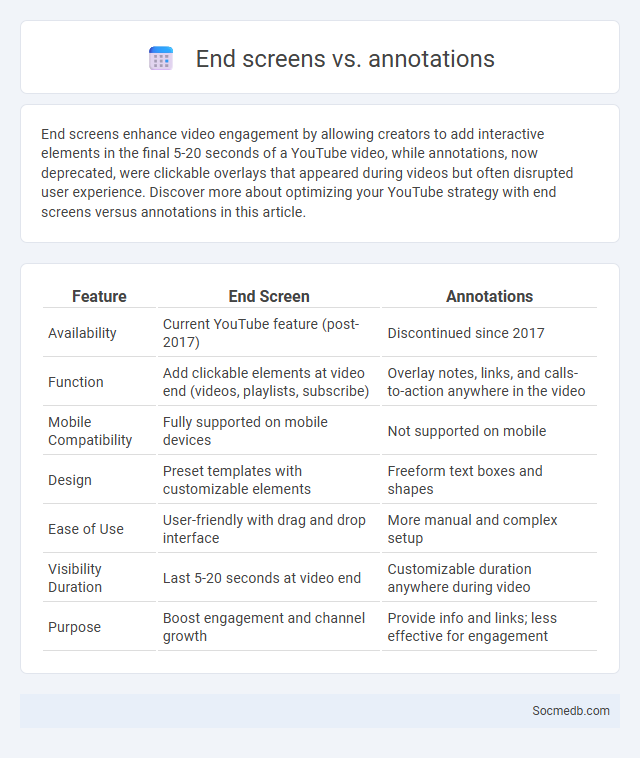
Photo illustration: End screen vs Annotations
End screens enhance video engagement by allowing creators to add interactive elements in the final 5-20 seconds of a YouTube video, while annotations, now deprecated, were clickable overlays that appeared during videos but often disrupted user experience. Discover more about optimizing your YouTube strategy with end screens versus annotations in this article.
Table of Comparison
| Feature | End Screen | Annotations |
|---|---|---|
| Availability | Current YouTube feature (post-2017) | Discontinued since 2017 |
| Function | Add clickable elements at video end (videos, playlists, subscribe) | Overlay notes, links, and calls-to-action anywhere in the video |
| Mobile Compatibility | Fully supported on mobile devices | Not supported on mobile |
| Design | Preset templates with customizable elements | Freeform text boxes and shapes |
| Ease of Use | User-friendly with drag and drop interface | More manual and complex setup |
| Visibility Duration | Last 5-20 seconds at video end | Customizable duration anywhere during video |
| Purpose | Boost engagement and channel growth | Provide info and links; less effective for engagement |
Introduction to YouTube Interactive Elements
YouTube interactive elements enhance viewer engagement by incorporating features such as cards, end screens, and polls within videos. These tools enable creators to drive traffic, boost subscriber counts, and increase watch time by prompting audience interaction. Leveraging YouTube's interactive capabilities improves content discoverability and fosters a stronger online community.
What Are End Screens?
End screens are interactive elements that appear during the last 5-20 seconds of a YouTube video, designed to promote other content, playlists, or encourage subscriptions. You can use end screens to increase viewer engagement by linking to your channel, merchandise, or external websites approved by YouTube. Implementing well-crafted end screens enhances your video's discoverability and helps grow your audience effectively.
Understanding Annotations on YouTube
Understanding annotations on YouTube enhances your video engagement by allowing interactive features like clickable links, notes, and call-to-actions. These annotations can guide viewers to subscribe, visit external sites, or navigate to related content, increasing viewer retention and channel growth. By mastering annotation strategies, you improve your video's interactivity and overall viewer experience.
Key Features of End Screens
End screens on social media platforms like YouTube offer interactive elements to boost viewer engagement by promoting additional videos, playlists, or subscription buttons within the last 5-20 seconds of a video. Key features include customizable call-to-action buttons, real-time analytics to track performance, and compatibility with mobile and desktop devices for broader audience reach. These tools enhance viewer retention and drive traffic to related content or channels, optimizing content visibility and subscriber growth.
Annotations: Pros and Cons
Annotations in social media enhance user engagement by providing additional context, interactive elements, and opportunities for personalized content, boosting content discoverability and audience retention. However, excessive or irrelevant annotations can clutter user interfaces, distract from core messages, and potentially degrade user experience, leading to lower engagement rates. Striking an optimal balance in annotation use is crucial for maximizing benefits while minimizing drawbacks across platforms like Instagram, TikTok, and YouTube.
End Screens vs Annotations: Direct Comparison
End Screens and Annotations serve distinct purposes in social media video content, with End Screens offering clickable elements like video links, playlists, and subscribe buttons displayed during the last 5-20 seconds, enhancing viewer engagement and retention. Annotations, now deprecated on platforms like YouTube, were overlays providing text, links, and hotspots but lacked mobile compatibility, limiting their effectiveness. Your choice between these tools directly impacts viewer interaction, with End Screens providing a more seamless, visually appealing, and mobile-friendly option for boosting channel growth.
Best Practices for Using End Screens
End screens on social media videos should include clear calls to action, such as subscribing to your channel or watching related content, to effectively increase viewer engagement. Positioning end screens within the last 5-20 seconds maximizes visibility without detracting from the video's core message. Your strategic use of end screens enhances audience retention and drives meaningful interactions across platforms.
Common Mistakes to Avoid with Annotations
Neglecting consistent posting schedules reduces audience engagement and algorithmic visibility. Overlooking audience analytics leads to ineffective content strategies and lower conversion rates. Ignoring platform-specific guidelines can result in content removal or account suspension, impacting brand reputation and growth.
YouTube’s Shift from Annotations to End Screens
YouTube's shift from annotations to end screens reflects a strategic move to enhance user engagement through mobile-friendly, interactive elements that promote video discovery and subscriber growth. End screens allow creators to add clickable links, video suggestions, and channel subscriptions in the last 5-20 seconds, optimizing viewers' experience across devices. This transition aligns with YouTube's emphasis on seamless navigation and monetization opportunities, significantly impacting content strategies and audience retention.
Choosing the Best Engagement Tool for Your YouTube Channel
Selecting the best engagement tool for your YouTube channel involves analyzing metrics like viewer retention, comment activity, and share rates to identify tools that foster interaction. Features such as live chat integration, poll creation, and customizable call-to-action overlays enhance audience participation and content feedback. Prioritizing tools compatible with YouTube's API ensures seamless integration and effective engagement tracking.
 socmedb.com
socmedb.com